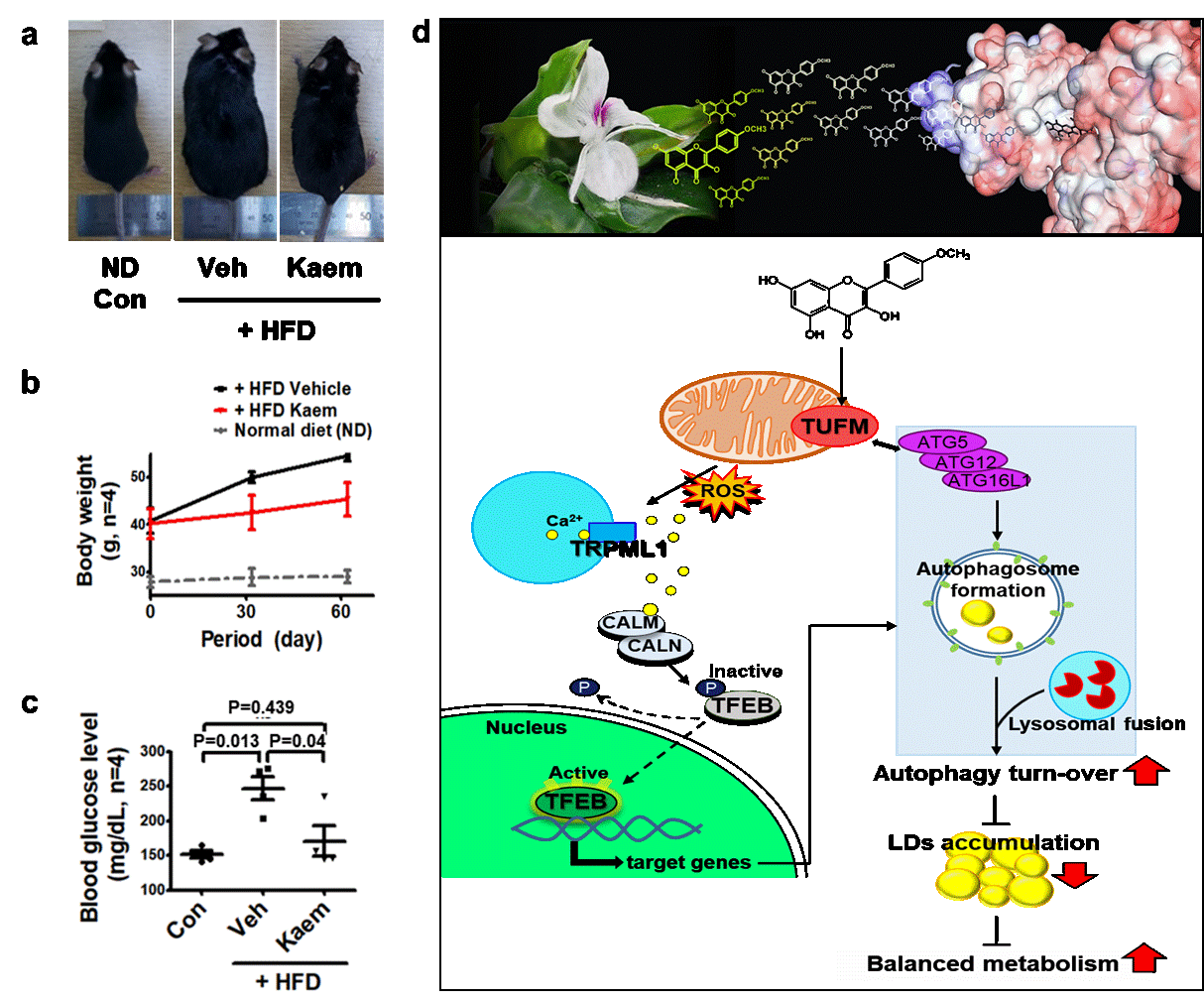Going Green: Natural Compound Kaempferide Could be Promising for Treating Metabolic Disorders
Scientists discover a naturally occurring compound that can treat obesity, dig into its biological mechanisms of action
Research published online in Communications Biology in January 2021

a. Mice with high fat diet (HFD)-induced obesity can be successfully treated by a naturally occurring compound called Kaempferide (Kaem). b. Graph showing the efficacy of Kaem in preventing obesity. c. Graph showing the efficacy of Kaem in reducing glucose levels in mice fed with HFD. d. The intracellular mechanisms by which Kaem achieves successful treatment.
Photo courtesy: Ho Jeong Kwon from Yonsei University, Korea
The human body has carefully controlled intricate systems in place that work in tandem to keep it healthy and functioning. One such system is ‘autophagy’, the process by which a cell degrades abnormal organelles and invading pathogens to clean itself out. This is key to maintaining cellular health. When autophagy becomes dysfunctional, metabolic diseases such as obesity, neurodegenerative diseases, and cancer can result. Autophagy regulators/stimulators are, thus, widely seen as a promising therapeutic possibility for these diseases.
Professor Ho Jeong Kwon, and his colleagues, from Yonsei University, Korea, have been investigating naturally occurring compounds and their roles in stimulating autophagy. "We’ve observed that natural compounds can improve biological functions in vivo and they have the advantage of being less toxic than synthetic drugs. We, therefore, set out to find the mechanisms underlying the disease-improving activities of these compounds", explains Prof. Kwon.
In their latest study, published in Nature’s Communications Biology, Prof. Kwon’s team screened 658 natural compounds to find one that enhanced autophagy. A compound called kaempferide (Kaem) fit the bill.
To find out what biological pathways Kaem induces in a cell, the team treated cell cultures with Kaem and, in a series of experiments, observed the effects. They found that Kaem binds to a protein called TUFM in the mitochondria (the cell organelle responsible for producing the energy needed for cellular functions to occur). This, via interaction with a specific set of proteins, and via a simultaneous cascade of events—involving the enabling of a protein called TFEB to move from the cytoplasm into the nucleus of the cell, where it triggers the expression of genes responsible for the formation of autophagosomes and lysosomes (vesicles in the cytoplasm where autophagy occurs)—enhances autophagy.
Having clarified the mechanism of action of Kaem, Prof. Kwon’s team set out to test whether Kaem is effective for lipid (fat) droplet metabolism. Prof. Kwon explains the rationale behind this effort: “Adipocytes (fat cells) story energy in the form of lipid droplets. When adipocytes become overloaded with lipid droplets, there is an increased risk of insulin resistance, which is a major cause of metabolic syndromes like obesity and diabetes. Lipid degradation via autophagy is a crucial way in which such overload is avoided, and the body is kept healthy.”
Their in vitro tests with adipocytes showed that lysosomes formed due to Kaem activity degraded lipid droplets and reduced their levels. In vivo, in mice with high fat diet-induced obesity, treatment with Kaem caused weight loss, the normalization of fatty liver, and improvement in glucose levels.
Explaining the significance of the results, Prof. Kwon says: "Our results demonstrate that Kaem is a potential candidate for treating metabolic disorders. They also clarify the importance of TUFM in regulating autophagy, opening up a new path for exploration related to treatments for metabolic diseases.”
Recommended Articles
Professor Myeong Min Lee
A QUIRKY twist of fate: understanding epidermis cell differentiation in plants
Professor Jihyun F. Kim
Microbial Mercenaries for Plant Disease Resistance Ungrounded